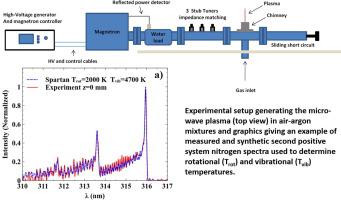当前位置:
X-MOL 学术
›
J. Mol. Spectrosc.
›
论文详情
Our official English website, www.x-mol.net, welcomes your feedback! (Note: you will need to create a separate account there.)
Experimental characterization of argon/air mixture microwave plasmas using optical emission spectroscopy
Journal of Molecular Spectroscopy ( IF 1.4 ) Pub Date : 2020-04-01 , DOI: 10.1016/j.jms.2020.111278 Sébastien Rassou , Alain Piquemal , Nofel Merbahi , Fréderic Marchal , Mohammed Yousfi
Journal of Molecular Spectroscopy ( IF 1.4 ) Pub Date : 2020-04-01 , DOI: 10.1016/j.jms.2020.111278 Sébastien Rassou , Alain Piquemal , Nofel Merbahi , Fréderic Marchal , Mohammed Yousfi

|
Abstract The plasma is generated by a microwave (MW) source inside a conditioned cell with an axial gas injection working at high pressure argon with a small admixture of air. Several characterization methods based on the analysis of the optical emission spectra are employed to determine rotational Trot, vibrational Tvib, excitation Tex and electron Te temperatures along the plasma flame axis. The densities of electrons and oxygen and nitrogen atoms are also determined from spectra analysis for the same plasma axis positions. The rotational and vibrational temperatures are simultaneously estimated using a new method based on the analysis of 3 consecutive band heads of the second positive system (SPS) of molecular nitrogen spectra. This new method, based on pre-calculated synthetic spectra databases, leads to Trot varying from about 2000 to 2500 K along the plasma axis while Tvib are higher (around 5000 K and more). Both temperatures are coherent when determined from N2SPS in the case of two distinct wavelength ranges (around 313 nm and 376 nm). These temperatures are in agreement with Trot determined from comparison between synthetic and experimental OH(A-X) spectra and Tvib determined from the first negative system N2+FNS spectra. The estimated electron temperatures Te are around 2.0 eV while the electron densities are in the range 1015 to 1016cm−3 using a literature method adapted in the present work to air diluted in argon buffer gas. The densities of atomic oxygen are estimated close to 1015 cm−3 and those of nitrogen close to 1016 cm−3 when using an actinometry method assuming a priori known the density of hot buffer argon gas at Trot temperature and also Tex determined using classical Boltzmann plots based on a chosen series of Ar lines. The significant deviations between the different temperatures Trot, Tvib, Tex and Te clearly underline a pronounced non thermal equilibrium of the present MW argon/air plasma. It is also shown an important chemical non-equilibrium since the measured electron, N and O densities are found much higher than the usual equilibrium densities generated by thermal dissociation and recombination processes. This therefore means that the energetic electron impacts play a significant role on the formation of the present non-equilibrium MW plasma.
中文翻译:

使用光发射光谱对氩气/空气混合微波等离子体进行实验表征
摘要 等离子体由微波 (MW) 源在调节池内产生,轴向注气在高压氩气和少量空气混合下工作。采用基于光学发射光谱分析的几种表征方法来确定沿等离子体火焰轴的旋转 Trot、振动 Tvib、激发 Tex 和电子 Te 温度。电子以及氧和氮原子的密度也由相同等离子体轴位置的光谱分析确定。使用基于分子氮光谱第二正系统 (SPS) 的 3 个连续带头分析的新方法同时估计旋转和振动温度。这种基于预先计算的合成光谱数据库的新方法,导致沿等离子体轴的 Trot 从大约 2000 到 2500 K 变化,而 Tvib 更高(大约 5000 K 或更多)。在两个不同波长范围(大约 313 nm 和 376 nm)的情况下,当从 N2SPS 确定时,两个温度是相干的。这些温度与根据合成和实验 OH(AX) 光谱之间的比较确定的 Trot 和根据第一个负系统 N2+FNS 光谱确定的 Tvib 一致。估计的电子温度 Te 约为 2.0 eV,而电子密度在 1015 到 1016cm-3 的范围内,使用在本工作中适用于在氩气缓冲气体中稀释的空气的文献方法。假设先验已知 Trot 温度下热缓冲氩气的密度以及使用经典玻尔兹曼图确定的 Tex,当使用光度计方法时,原子氧的密度估计接近 1015 cm-3,氮原子的密度接近 1016 cm-3基于一系列选定的 Ar 线。不同温度 Trot、Tvib、Tex 和 Te 之间的显着偏差清楚地强调了当前 MW 氩气/空气等离子体的明显非热平衡。它还显示出重要的化学非平衡,因为发现测量的电子、N 和 O 密度远高于由热解离和复合过程产生的通常平衡密度。因此,这意味着高能电子撞击对当前非平衡 MW 等离子体的形成起着重要作用。
更新日期:2020-04-01
中文翻译:

使用光发射光谱对氩气/空气混合微波等离子体进行实验表征
摘要 等离子体由微波 (MW) 源在调节池内产生,轴向注气在高压氩气和少量空气混合下工作。采用基于光学发射光谱分析的几种表征方法来确定沿等离子体火焰轴的旋转 Trot、振动 Tvib、激发 Tex 和电子 Te 温度。电子以及氧和氮原子的密度也由相同等离子体轴位置的光谱分析确定。使用基于分子氮光谱第二正系统 (SPS) 的 3 个连续带头分析的新方法同时估计旋转和振动温度。这种基于预先计算的合成光谱数据库的新方法,导致沿等离子体轴的 Trot 从大约 2000 到 2500 K 变化,而 Tvib 更高(大约 5000 K 或更多)。在两个不同波长范围(大约 313 nm 和 376 nm)的情况下,当从 N2SPS 确定时,两个温度是相干的。这些温度与根据合成和实验 OH(AX) 光谱之间的比较确定的 Trot 和根据第一个负系统 N2+FNS 光谱确定的 Tvib 一致。估计的电子温度 Te 约为 2.0 eV,而电子密度在 1015 到 1016cm-3 的范围内,使用在本工作中适用于在氩气缓冲气体中稀释的空气的文献方法。假设先验已知 Trot 温度下热缓冲氩气的密度以及使用经典玻尔兹曼图确定的 Tex,当使用光度计方法时,原子氧的密度估计接近 1015 cm-3,氮原子的密度接近 1016 cm-3基于一系列选定的 Ar 线。不同温度 Trot、Tvib、Tex 和 Te 之间的显着偏差清楚地强调了当前 MW 氩气/空气等离子体的明显非热平衡。它还显示出重要的化学非平衡,因为发现测量的电子、N 和 O 密度远高于由热解离和复合过程产生的通常平衡密度。因此,这意味着高能电子撞击对当前非平衡 MW 等离子体的形成起着重要作用。



























 京公网安备 11010802027423号
京公网安备 11010802027423号